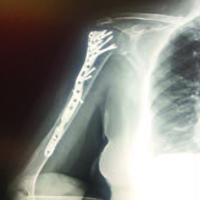How to treat proximal and middle one-third humeral shaft fractures: The role of helical plates

All claims expressed in this article are solely those of the authors and do not necessarily represent those of their affiliated organizations, or those of the publisher, the editors and the reviewers. Any product that may be evaluated in this article or claim that may be made by its manufacturer is not guaranteed or endorsed by the publisher.
Complex proximal third diaphyseal humeral fractures are uncommon patterns of injury mainly caused by high energy trauma. The anatomical shape of the humerus, the presence of the deltoid tuberosity and the close proximity of the radial nerve into the radial groove represent challenge elements to deal with. Historically, straight plates were manually twisted; subsequently, helical plates created for other anatomical sites (as distal tibia) were used in humeral fractures. In both these experiences surgeons observed several disadvantages. More recently, dedicated helical plates have been created. In this study, we expose our surgical technique for using helical humeral plates (A.L.P.S.® Proximal Humeral Plating System, Zimmer Biomet), with its advantages and operative recommendation.
From 2019 to 2021, nine patients who were admitted to our institution for humeral fractures involving the proximal third diaphysis have been treated with humeral helical plates. At one and six months after surgery, standard antero-posterior and lateral radiographs were obtained, and at last follow-up (fourteen months on average) clinical evaluation was performed through range of motion assessment, Constant score and DASH score questionnaires. At six months, all fractures have healed. At last follow-up (fourteen months on average, 6-22) the average range of motion were flexion 135° (90°-180°); abduction 124° (85°-180°); external rotation 52° (20°-80°), internal rotation at L3 (between scapulae-trochanter). Average Constant Shoulder Score was 70 (33-96), average Dash score was 21 (range 1,7-63). Three patients experienced temporary radial nerve palsy from injury, with subsequently improvement at EMG analysis within eight months from surgery. In our opinion this strategy avoids the deltoid tuberosity and reduces the risk of radial nerve injury, increasing the possibility of a rapid functional recovery after surgery.
Nowak LL, Dehgahn N, McKee MD. Plate fixation for management of humerus fractures. Injury 2018;49:S33-8. DOI: https://doi.org/10.1016/S0020-1383(18)30300-0
Sarmiento A, Zagorski JB, Zych GA, et al. Functional bracing for the treatment of fractures of the humeral diaphysis. J Bone Jt Surg Am 2000;82:478-86. DOI: https://doi.org/10.2106/00004623-200004000-00003
Gaebler C, McQueen MM, Court-Brown CM. Minimally displaced proximal humeral fractures: epidemiology and outcome in 507 cases. Acta Orthop Scand 2003;74:580–5. DOI: https://doi.org/10.1080/00016470310017992
Tetsworth K, Hohmann E, Glatt V. Minimally invasive plate osteosynthesis of humeral shaft fractures: current state of the art. J Am Acad Orthop Surg 2018;26:652-61. DOI: https://doi.org/10.5435/JAAOS-D-17-00238
Zhang L, Chen LW, Zhang W, et al. Treatment of proximal and middle one-third humeral fractures with lateral distal tibial helical plate. Eur J Orthop Surg Traumatol 2011;22:673-9. DOI: https://doi.org/10.1007/s00590-011-0929-0
Maresca A, Pascarella R, Bettuzzi C, et al. Multifocal humeral fractures. Injury 2014;45;444-7. DOI: https://doi.org/10.1016/j.injury.2013.10.010
Dell’Oca AAF. The principle of helical implants. Unusual ideas worth considering. Injury 2002;33:SA1-2. DOI: https://doi.org/10.1016/S0020-1383(02)00064-5
Yang KH. Helical plate fixation for treatment of comminuted fractures of the proximal and middle one-third of the humerus. Injury 2005;36:75-80. DOI: https://doi.org/10.1016/j.injury.2004.03.023
Da Silva T, Rummel F, Knop C, et al. Comparing iatrogenic radial nerve lesions in humeral shaft fractures treated with helical or straight PHILOS plates: a 10‑year retrospective cohort study of 62 cases. Arch Orthop Trauma Surg 2020;140:1931-7. DOI: https://doi.org/10.1007/s00402-020-03438-y
Moon JG, NamKwon H, Sandeep B, et al. Minimally Invasive Plate Osteosynthesis using a helical plate for metadiaphyseal complex fractures of the proximal humerus. Orthopaedics 2014;37:237-43. DOI: https://doi.org/10.3928/01477447-20140225-55
Wang Q, Hu J, Guan J, et al. Proximal third humeral shaft fractures fixed with long helical PHILOS plates in elderly patients: benefit of pre-contouring plates on a 3D-printed model—a retrospective study. J Orthop Surg Res 2018;13:203 DOI: https://doi.org/10.1186/s13018-018-0908-9
Ruedi TP, Murphy WM. AO principles of fracture management,1. Stuttgart, New York: Thieme; 2000.
Benninger E, Meier C. Minimally invasive lateral plate placement for metadiaphyseal fractures of the humerus and its implications for the distal deltoid insertion – it is not only about the radial nerve. A cadaveric study. Injury 2017;48:615-20. DOI: https://doi.org/10.1016/j.injury.2017.01.026
Robinson MC, Stirling PHC, MacDonald DJ, et al. Open reduction and long locking plate fixation of complex proximal humeral metaphyseal fractures. J Bone Joint Surg Am 2020;102:2146-56. DOI: https://doi.org/10.2106/JBJS.20.00372
Dauwe J, Grechenig P, Unterfrauner I, et al. Axillary nerve elongation in humeral fracture plating: A cadaveric study for comparison between straight and helical Philos plates. J Orthop 2020;19:233–6. DOI: https://doi.org/10.1016/j.jor.2020.02.009
Krishna KR, Sridhar I, Ghista DN. Analysis of the helical plate for bone fracture fixation. Injury 2008;39:1421-36. DOI: https://doi.org/10.1016/j.injury.2008.04.013
Gill DRJ, Torchia ME. The spiral compression plate for proximal humeral shaft nonunion: a case report and description of a new technique. J Orthop Trauma 1999;13:141-4. DOI: https://doi.org/10.1097/00005131-199902000-00013
PAGEPress has chosen to apply the Creative Commons Attribution NonCommercial 4.0 International License (CC BY-NC 4.0) to all manuscripts to be published.


 https://doi.org/10.4081/std.2021.9175
https://doi.org/10.4081/std.2021.9175



